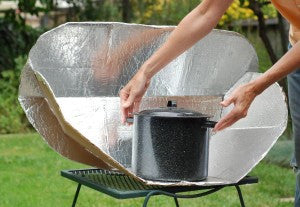
Solar Cooking 101
All too often, people who find themselves in emergency situations realize that they may have food to last them for several days, but they have absolutely no way to cook their food without power. Emergency situations often include a loss of power for some period of time, and if you don’t have a backup method of cooking your food, you’re going to have to do a lot of raw eating. There are a variety of emergency cookstoves, dutch ovens, and barbecues to choose from if you’ve planned in advance, but today we are going to talk about solar cooking, a cheap, easy, and excellent option for emergency cooking if the weather is right.
Not only is solar cooking a great backup cooking method for emergency situations, it’s also great for non-survival times as well. Cooking your food with a solar oven outside in the sunshine helps you save money on your utility bill and keeps the kitchen from getting heated up on hot summer days. If you need a few more reasons to look into solar cooking, try these:
-
Solar ovens cook food at moderate temperatures as opposed to the higher heat of traditional ovens. This low, slow cooking preserves more nutrients in your food than higher temperatures can.
-
Solar ovens can double as water purifiers in emergency situations.
-
Solar cooking is hands-off. Just put your food in in the morning and come back at the end of the day to a ready meal.
-
There’s something uniquely delicious about food cooked with sunshine.
If you’re convinced now that solar cooking should be the next survival skill you pick up, here’s some how-to information so you can get experimenting in your own backyard.
How to Make Your Own
Solar ovens can be purchased for anywhere from thirty dollars to three hundred dollars, but making one at home is easy to do and requires simply objects you probably already have somewhere in your home. Last year I built a solar oven out of a car windshield shade, some velcro, a small wire cooling rack, and a large plastic bag. This oven works just as well as most, and it cost me less than five dollars to put together.
If you’re interested in making your own oven, you can find a variety of plans (including the one I made from a windshield shade) at www.solarcooking.org. Many of these plans simply need a cardboard box, aluminum foil, and tape.
Solar Cooking Tips
Solar cooking is all about experimenting to see what works best for your particular area/oven/food/etc. The more you practice, the better you will be, and the more you will want to cook in your solar oven. You will find as you experiment that you can cook almost anything in a solar oven, from stews and casseroles to breads and desserts. Temperatures in solar ovens only get to about 200-300 degrees fahrenheit depending on weather conditions, so it will simply take longer to cook. Here are a few tips and tricks to help you along your solar cooking way:
-
Of course, solar ovens need sunshine, so they work best on days that are nice and hot. However, they can work perfectly on mild winter days as well. Last year I used my homemade solar oven to boil eggs on a 45-degree day in early March. If you live in an area that has cold or rainy seasons, experts say you can cook in your cooker in all but the coldest three months of the year. The key is to make sure the day is a clear, sunny day when the sky is bright blue and there is not too much wind.
-
Optimal times for cooking are usually between 10 a.m. and 2 p.m. as this is when the sun is highest in the sky. Experts say 20 minutes of sunshine per hour ensures your food won’t spoil.
-
You may want to stick around to keep an eye on your food the first few times you use your cooker. If the sun moves and shadows start to creep onto your food, you will need to turn your cooker to face the sun. After you have used it a few times, you will figure out the perfect placement for your cooker.
-
Solar cooking works best with dark-colored pots that aren’t too thick. (Cast iron pots, for example, are not ideal.) If you don’t have a black pot, you can paint its exterior.
-
Solar cooking works quicker at higher altitudes and slower at lower ones. Keep this in mind as you gauge your cooking time.
Now that spring is here for most of us, it’s the perfect time to start experimenting with solar cooking. If you use these sunny days to master your solar cooking skills, you’ll be glad you did if you ever find yourself without power and needing to cook a meal for your family.
The post Solar Cooking 101 appeared first on Buy Emergency Food.


